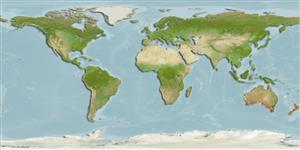Actinopterygii (peixes com raios nas barbatanas) >
Mugiliformes (Mullets) >
Mugilidae (Mullets)
Etymology: forsteri: Named for F.C. Aldrich, former Chief Inspector of Fisheries and Game, Western Australia and J.R. Forster, naturalist on Cook's second voyage to New Zealand (Ref. 9003).
Ambiente / Clima / Intervalo
Ecologia
; marinhas; Água doce; estuarina demersal; catádromo (Ref. 46888); intervalo de profundidade 0 - 50 m (Ref. 9003), usually 0 - 10 m (Ref. 9812). Temperate; ? - 28°C (Ref. 28706), preferred ?; 25°S - 47°S, 112°E - 173°W
Southwest Pacific: throughout New Zealand and the Chatham Islands; also from eastern, western Australia, southern Australia and Tasmania.
Tamanho / Peso / Idade
Maturity: Lm ? range ? - ? cm
Max length : 50.0 cm SL macho/indeterminado; (Ref. 44894); common length : 25.0 cm TL macho/indeterminado; (Ref. 9258); Peso máx. publicado: 950.00 g (Ref. 26498); Idade máx. registada: 7 anos (Ref. 9003)
Espinhos dorsais (total): 5; Raios dorsais moles (total): 9; Espinhos anais 3; Raios anais moles: 12. More pointed head and mouth than Mugil cephalus, and their eyes lack adipose (fatty) eyelids. Body scales are small (54-64 between gill opening and tail base) and thin, and are easily dislodged. 2 widely separated dorsal fins, the first with 4 spines and the second with 1 spine and 9 rays. These fish are olive or bluish brown above and silvery on the sides, and their eyes are bright yellow or golden. The fins have brown margins.
Found over sandy and muddy bottoms of coastal waters, bays, estuaries, and may ascend rivers into freshwaters (Ref. 9812, 44894). Adults inhabit brackish coastal lakes (Ref. 44894). Found in schools (Ref. 9812). Shoal-forming (Ref. 44894). They are omnivores, feeding mostly on benthic detritus, algae and small invertebrates. Oviparous, eggs are pelagic and non-adhesive (Ref. 205). Spawn in coastal waters in summer and autumn, probably in estuaries (Ref. 9812, 27012, 28470, 28707, 28708). Marketed fresh (whole gutted or fillets), smoked, salted or as roe (Ref. 3383).
Yellow eye mullet form large aggregations prior to spawning (Ref. 6390).
Kailola, P.J., M.J. Williams, P.C. Stewart, R.E. Reichelt, A. McNee and C. Grieve, 1993. Australian fisheries resources. Bureau of Resource Sciences, Canberra, Australia. 422 p. (Ref. 6390)
Categoria na Lista Vermelha da IUCN (Ref. 115185)
CITES (Ref. 94142)
Not Evaluated
Utilização humana
Pescarias: espécies comerciais; peixe desportivo: sim
Mais informação
ColaboradoresFotografiasStamps, CoinsSonsCiguateraVelocidadeTipo de nataçãoÁrea branquialOutras referênciasCérebrosVisão
Ferramentas
Relatórios especiais
Descarregue XML
Fontes da internet
